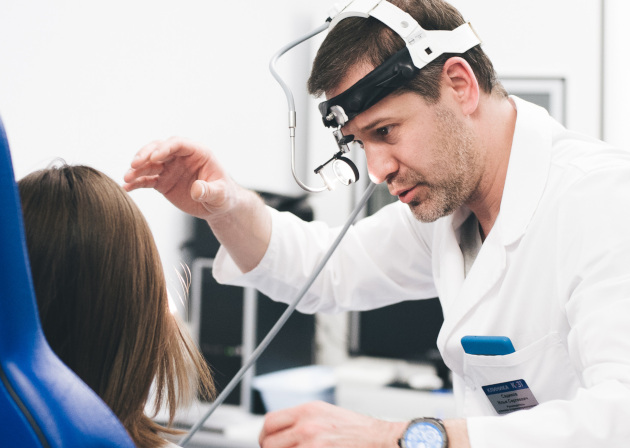Acute sinusitis
Sinusitis is a disease of the paranasal sinuses (PS) of an inflammatory or allergic nature. Most often, inflammation occurs in the maxillary sinus (sinusitis); inflammation of the cells of the ethmoidal labyrinth (ethmoiditis), frontal (frontal sinusitis) and sphenoid (sphenoiditis) sinuses also occurs. However, more often the process spreads not to one, but to several sinuses - polysinusitis occurs, if all paranasal sinuses are involved - pansinusitis.

specialists

equipment

treatment
More about the disease

Acute sinusitis - the most common causes are acute respiratory diseases, viral infections (such as influenza), hypothermia, colds, general bacterial infections, and injuries.
The course of the disease can be aggravated by a curvature of the nasal septum, hypertrophy of the inferior or middle turbinates, impaired immunity, an allergic process, and enlargement of the nasopharyngeal tonsil (adenoid vegetations in children).
Symptoms of acute sinusitis:
- Runny nose for more than 7-10 days, without signs of improvement.
- Nasal congestion, mucous or purulent discharge from the nose.
- Mucus running down the back of the throat, copious discharge of purulent sputum in the morning.
- Headache, heaviness and pain in the inflamed sinus area. Sometimes there is pain in the teeth, eyes, cheekbones, cheeks.
- Increased sensitivity of the facial skin in the projection of the affected sinus.
- Increased body temperature (up to 380C and above). As a rule, this symptom is observed in an acute case. In a chronic process, body temperature rarely rises or remains at subfebrile levels (37-37.50C).
- Weakness, fatigue, irritability. Photophobia, lacrimation, loss of appetite, sleep disturbance.
- Weakened or absent sense of smell.
- Swelling of the cheeks and eyelids.

Reasons:
- Curvated nasal septum.
- Chronic rhinitis.
- Anomalies of the anastomosis (opening) between the sinus and the nasal cavity.
- Allergic reactions.
- Decreased immunity.
- The presence of foci of chronic infection (chronic tonsillitis, dental pathology).
- Polluted environment.
- Fungal infection, etc.
A factor that provokes an exacerbation of sinusitis can be a viral infection or hypothermia. In the case of an odontogenic process, the triggering factor can be dental manipulation.
During the rhinogenic process, swelling of the mucous membrane of the nasal cavity and sinuses occurs, disruption of the natural cleansing (drainage) of the paranasal sinuses and stagnation of secretions (mucus). Stagnation of secretions and impaired ventilation are the starting point for the activation of the inflammatory process.

How is an appointment with an otolaryngologist at K+31?
Our doctors

This award is given to clinics with the highest ratings according to user ratings, a large number of requests from this site, and in the absence of critical violations.

This award is given to clinics with the highest ratings according to user ratings. It means that the place is known, loved, and definitely worth visiting.

The ProDoctors portal collected 500 thousand reviews, compiled a rating of doctors based on them and awarded the best. We are proud that our doctors are among those awarded.
Make an appointment at a convenient time on the nearest date
Price
































It should be remembered